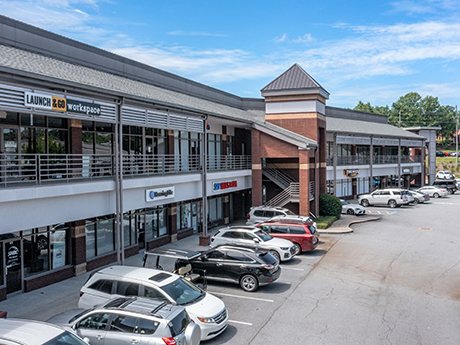By Jeff Enck, senior vice president, SRS Real Estate Partners
Throughout the world of retail investment sales, reality is setting in.
Buyers and sellers of unanchored retail shops are adjusting to lingering market uncertainty, which, at least for now, seems to be here to stay. Over the past 12 to 18 months, the Federal Reserve has doused the white-hot, inflation-powered economy with buckets of interest rate hikes, increasing the effective federal funds rate from .08 percent at the beginning of 2022 to 5.08 percent today.
Based on the central bank’s latest public signals, it doesn’t appear that interest rates are coming back down anytime soon. But it’s important to note that, historically speaking, they are not significantly high.

Debt Challenges Continue
Insurance companies, credit unions and relationship-driven lenders are financing the majority of retail deals in the market today. Typical bank loans, however, have slowed significantly as some institutions are either inactive or face rates are too high to meet debt service coverage ratios. Some private investors are buying with all cash or closing with cash plus lines of credit.
A recent example of a “new normal” deal involves a life insurance company loan on a purchase transaction of a $15 million center in suburban Atlanta with 40 percent cash down, a 5.9 percent interest rate with two years of interest-only payments and the remaining 10-year term amortized over 30 years. In this instance, the cap rate was 7.54 percent, so if you’re doing the math, that equates to an approximate cash-on-cash return of 10 percent in year one.
With the cash-heavy 1031 exchange buyer on a smaller acquisition — say a $3.5 million, 7.5 percent cap property — the deal might have $2 million in cash with a small loan of $1.5 million at 7 percent over a 20-year amortization period. The numbers aren’t pretty, but the buyer parks tax-deferred money into a long-term investment that he or she expects good appreciation on. We are seeing variations of this scenario play out frequently.
Perhaps the most noteworthy takeaway among the current market conditions is that most unanchored retail investment offerings are not garnering dozens of offers; rather, offers trickle in and sellers wait a little longer to make a deal. Pricing, somewhat surprisingly, has not made a major adjustment, despite a drop in activity. Why is this? More on that in a moment.
Funds Flush
Meeting activity at ICSC Vegas was as busy as it has ever been, and a theme that ran throughout most meetings is that many investors have plenty of money to spend. Seemingly every fund we met with had either a new partnership, recapitalization or fresh money raise.
However, most funds are not closing on as much product as they would like, as they still have to solve for a return and in many cases —particularly for smaller sized transactions — there is the expected disconnect between debt service requirements and cap rates. Several funds mentioned that the ratio of deals that make it to committees compared with deals that close are down significantly. Investors using other people’s money who have to pay a return are being outbid by individual buyers, family offices and 1031 exchange players.
Multi-Tenant Retail Inventory Falls
A lack of salable supply is still holding pricing somewhat steady for multi-tenant retail shops. The number of offers per deal are down. However, 1031 and private buyers are carrying the load, albeit a smaller one, as inventory is significantly down from last year. There are still buyers available for quality strip centers, outparcel shops and shadow centers. As previously mentioned, most private buyers are transacting with low leverage (40 to 50 percent cash down).
STNL Abundance
Overall trading volume for single-tenant net-leased (STNL) properties is down 35 to 50 percent relative to last year’s velocity. A similar scenario seems to be playing out in that buyers are continuing to show up, but at a slower pace.
As is typical in times of transition and uncertainty, there is a flight to quality, with investors focusing more on credit and location quality. The 5- and 10-Year Treasury yields dipped in early April and again in early May, which seems to have led to 1031 apartment sales being triggered. The result was short bursts of offer activity, which should lead to an upward bump in net-leased transactions in the third quarter.
Crossover Product
Low-management, multi-tenant retail centers rest in between the strip centers, which are suffering from a lack of inventory, and the over-supplied net-leased properties. In other words, smaller multi-tenant assets have a fairly moderate inventory currently available on market.
There is always a flight to safety in times of uncertainty. There remains good traction for well-leased, well-located outparcel shops. Seasoned product is slightly favored by buyers over brand new properties, as rents tend to be lower and tenants have a track record at those locations.
Refi Bubble?
Continued high interest rates could lead to a potential real estate recession and/or an REO cycle. The latter term refers to properties that are foreclosed upon and that go back to the lender.
A couple key factors impacting the current retail investment sales market are:
- Retail properties overall are roughly 95 percent occupied in most major metropolitan areas.
- Tenants are, for the most part, doing well with more stores continuing to open versus close.
- Investors are generally sitting on healthy cash reserves, and the majority of loans transacted in the past 12 to 36 months before the dramatic interest rate increases have been lowly leveraged.
So what happens when these three- and five-year balloons come due? It seems logical that investors will be making uncomfortable decisions of refinancing with more cash (and/or less cash flow), paying off and in some cases selling. We don’t expect a major cycle of properties to go back to lenders, but we will likely see some isolated cases.
Despite the economic uncertainty, retail is emerging as one of the most favored property types at the moment, and unanchored retail remains a strong long-term investment as restaurants, convenience retailers and experience-based tenants continue to thrive.
–Jeff Enck is a senior vice president with SRS Real Estate Partners specializing in the sale of unanchored shopping centers.


